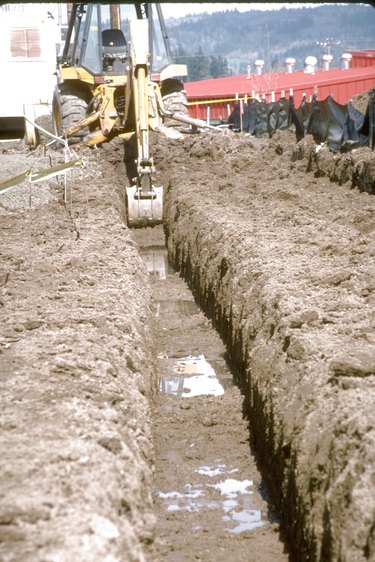
The typical basement offers a storage area, additional living space and a foundation to support the weight of the house. Because basements sit below-grade, they are subject to moisture problems and soil movement. If you need to seal the basement walls, add exterior drain tile or tie into the foundation for an addition, you'll have to excavate. Before digging, speak with your local building authority about safe digging practices and local foundation codes.
Walls and Footings
Video of the Day
Today's contractors pour standard 8-foot-high walls set on footers. The footers, which are wide and shallow, secure the bottom of the basement walls. Before the contractor pours the footings, he fills the forms with steel reinforcement rods that extend upward 2 to 3 feet. After the concrete footings harden, the contractor will pour the basement walls over the extending steel rods. This adds structural integrity to the walls, reducing the risk of shifting.
Video of the Day
Structurally-Sound Basement Walls
If you need to expose the exterior of the basement wall and the foundation is in good shape, you can dig a trench right next to the wall all the way down to the footing. To be on the safe side, consult an engineer or a foundation contractor before you start digging. When you reach the bottom of the basement wall, the footer will extend outward about 8 inches. You can dig beside the footer but do not dig out from beneath the footer since your home depends upon this soil being compact.
Building an Addition
A backhoe or other excavating equipment is necessary for removing large amounts of soil if you're building an addition. The excavation contractor will dig very close to the existing basement walls to expose the wall and the footing if you're constructing a full basement beneath the new addition. Before pouring the new footings, the contractor will drill holes into the existing footings and insert steel rods that will tie the old footings and the new ones together to form a solid base.
Unsound Basement Walls
On older homes or those where the basement is not structurally sound, a foundation contractor should oversee the digging. If there is a chance that the wall will collapse outward, the contractor might dig narrow vertical holes along the wall without exposing the entire wall down to the footing. He will then anchor the wall in sections, often by pouring columns of concrete, called "dead men," before digging away the rest of the soil.